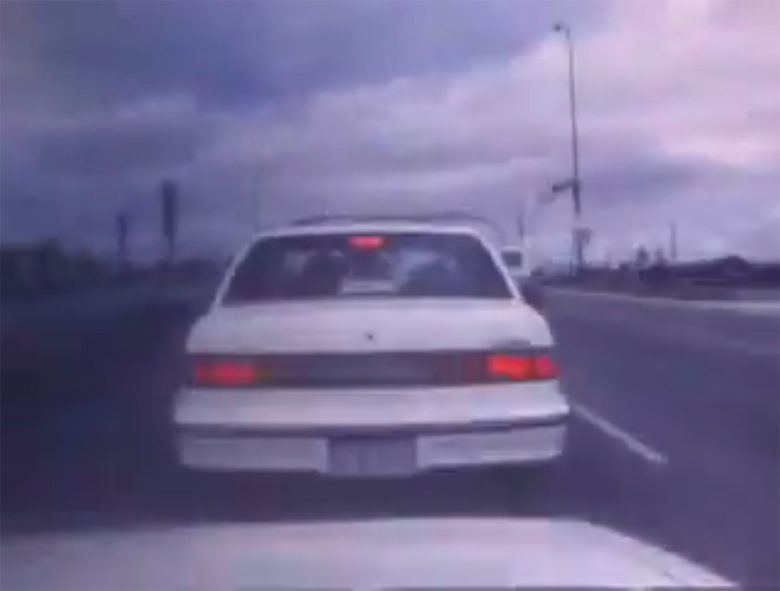Three things: Rick Doe, Answer Print, and the amateur film community in Calgary.
Those are the three things that made the festival possible.
— Gordon Pepper
After thumbing through a mountain of photos at the Calgary Society of Independent Filmmakers (CSIF) office in 2016, I placed a call to Gordon Pepper. I was looking to get a more personal perspective on the history of the $100 Film Festival—now the Artifact Small Format Film Festival—for a retrospective program for the festival’s 25th year. Pepper, one of the inaugural members of the festival in 1992, and now Executive Director of Filmpool Cooperative in Saskatchewan, was all over those photos. His excitement came bounding through the receiver as he began with the festival’s founder: James Beattie Morison.
Morison, an engineer with a love for film, exemplified the hungry and energetic amateur celluloid artist crowd in Calgary in the early nineties. He had a library of self-produced celluloid films, and ideas waiting to be realised. When he came to Calgary from Winnipeg, Morison took film classes at the University of Calgary and Southern Alberta Institute of Technology (SAIT), and also joined the board of CSIF. As a board member, he immediately pursued actions to revive interest in the dying medium, and proposed a casual congregation of filmmakers and film lovers—screenings and filmmaking workshops seeking to encourage and nurture local film production. Morison’s notes for the first event feature a brief outline of the submission guidelines, and scrawled marginalia to “get people who are positive … Jerre Paquette … warm & gentle,” “keep it loose,” “not flashy,” and “beer and discussion afterward.”
The rules were simple because the overall budget was determined by the cost of Super 8 film; $100 could buy you five rolls of black-and-white, four rolls of colour, or three rolls of sound film. This constraint bred sustainability, while making the festival unique and approachable—especially for novice filmmakers. “It was an entry point,” described Pepper, an open door for those seeking an audience, mentorship, and resources. Morison’s proposal was built upon and tethered to the ethos of CSIF: the principle of mutual assistance, and shared benefit. Those eager to make, share, and discuss films came together within this cooperative and found support. The idea of a scaled down budget and malleable materials must have held even more appeal to artists during this time, as the inception of $100FF coincided with some of the deepest funding cuts to the independent industry. Under Jean Chrétien’s Liberal government, funding was rolled back on Telefilm, the National Film Board, and several Provincial Arts Councils.1For artists lumbering through the drought of governmental funding, the prospect of a self-propelled project was becoming a reality, and the festival’s low entry fee of $10 levelled the playing field.
Recycled film scraps became potent, coated both with previous meaning, and new contextualization by proxy of fellow splices.
What resulted was a dedicated grouping of artists such as Joe Kelly and Noel Bégin—graduates of art programs and active local filmmakers. Kelly explored myriad materials and was eager to develop a film dimension to his practice. Bégin had just returned from film school and focused mainly upon abstract and experimental short films. Both filmmakers re-introduced scraps of film as sutured and emboldened cultural and political statements. Recycled film scraps became potent, coated both with previous meaning, and new contextualization by proxy of fellow splices. It is critical, anthropological, reflective, political, and altogether heuristic. Others like Don Best partook in the tradition of direct celluloid manipulation, applying a camera-less technique to produce haunting and consuming animation. Brenda Whiteman and Peter Stinson found a camera and film in a garage, and made the first of their many films for the $100FF. All of these artists constituted a small cross-section of Calgary at the time—people either seasoned in Super 8 or complete neophytes, coming together to share their films.
The first $100FF took place in 1992 in the basement theatre of a church at 1703 1st NW—which was also the CSIF headquarters. An intimate overcapacity audience took in a collection of seven films, each introduced by its author: Grave Delusions by Howard Horwitz, You Know What They Say by Pete McGowan, Before the Collage by A.R.W. Belyea, A Weekend in Calgary by James Morison, The Wandering Jew by Robert Manning, Tender by Greg Danyluk, and Left Brain Right Brain by Jeff Langille. Although a glaringly male first screening—indicative of a persisting gender imbalance in filmmaking then and even now—the festival was timely and indicative of popular demand. Close to 90 people squeezed into a 30-seat theatre.2Fuelled by minimal grant funding and volunteer labour, the inaugural festival was a wild success.
The festival is a contextual mélange, casting an ever-changing hue on the audience’s experience and expectation.
The audience quickly outgrew its humble basement theatre and the festival had to relocate: a pattern that continues to occur. As $100FF has aged, it necessitates a new home every few years. Likewise, its transitory curators take turns re-inventing its yearly programming. The history of $100FF involves constant recalibration of spatial coordinates and visual trends. Nomadic in nature, it has toured Calgary’s independent venues from the crowded church basement on 1st, the Gary Theatre, Alberta College of Art and Design, Globe Cinema, and The Plaza Theatre to its present home, the Calgary Engineered Air Theatre. The festival has mingled with the respective histories of each venue and its mandate. The festival is a contextual mélange, casting an ever-changing hue on the audience’s experience and expectation.
By 1995, the festival didn’t show all of its submissions. For the first time, a selection process was established and implemented by a programming committee. Additionally, the production cost was no longer defined for filmmakers. As the suggested budget fell away, the expressive potential inherent in the medium swelled. Gradually the festival began re-writing and re-defining Calgary’s film criterion for local and global audiences. Annually, works and authors were elected by the audience as inductees into the festival’s own enduring canon, a shrine that exists and grows with every passing year as a catalogue of what film has been and can be.
Pepper moved on to the second person that was essential to the development of the festival: Rick Doe. Doe moved to Calgary from Vancouver in 1975, and worked at Cine Audio film lab until he eventually bought it, re-naming it The Local Lab Movie Film Services in the late 1970s. The Local Lab, which he closed in 2004 just months before he passed away, was a driving force for Western Canada’s film community, and one of the main proponents of the $100FF’s success. Early on, The Local Lab mainly processed orders for the Canadian Armed Forces and oil firms, but soon it became the only place to process Super 8 in Calgary—one of a handful in Canada. Doe’s Lab was a hub for film discussion, mentorship, and camaraderie. He would often work long hours on tight deadlines for $100FF participants, and made it to every screening. In an interview with FFWD in 2004, Rick Garbutt—local camera operator, special-effects technician, and long-time personal friend of Doe's—said, “He really gave a damn about what he was doing. He would take your project by the hand and walk it through the way other labs will only do if they see a name like Paramount on the can.”3
The third person Pepper mentioned was Stephen Hanon, one of the board members that welcomed Morison’s original $100FF pitch. Hanon was a film enthusiast, and the soon-to-be editor of CSIF’s newsletter Answer Print. For many CSIF members, Hanon’s newsletter became an almanac of sorts, featuring works and events by and for members as well as invaluable resources and information. Each issue featured spotlight articles of members and their work, contemporary reviews of films and film-related books, general meeting information, production updates, and a calendar of local events. In keeping with Hanon’s empathetic tone, a section titled “Where To Ask For Buck$ For Your Film,” listed organizations interested in funding filmmakers who had “exhausted” all of their own private funding sources.
In one of Answer Print’s first issues in 1992, Hanon summed up his goal for the publication:
I believed a year ago, and I believe now, that a newsletter would not only be useful but essential to the members of the CSIF, to enable them to communicate among themselves and with the community at large. I believe that this newsletter, as nothing else, will help create a sense of community with the co-op. I see the newsletter, in part, as a forum for ideas about film and filmmaking. . . . Through the newsletter you will become aware that other people here have similar ambitions, weaknesses, knowledge and skills, frustrations, and need for encouragement, and support. You are not alone.4
In the evolutionary spirit of CSIF, Answer Print expanded in 2015 into the publication you are reading, Luma Quarterly, an online film and media journal co-published with EMMEDIA Gallery & Production Society. Through Luma, the publication continues to be a forum to ideas about film and filmmaking, while partnering with digital media, and engaging in conversation between the two worlds. Rather than committing to a binary existence opposing other forms of image acquisition, CSIF and the $100FF’s dedication to celluloid exists alongside other mediums without debate. Both digital and celluloid streams further furnish the core mandate of CSIF: providing attainable and affordable means by which filmmakers can undertake projects.
Now in its 26th year, and in the same shape-shifting adventurous spirit, $100FF has donned a new but familiar name: Artifact Small Format Film Festival. It is a fitting revolution considering the festival’s past and its adaptive ability to grow according to the form and context of its medium. Art/i/fact conjoins the artfulness and authenticity of the temperamental medium of film, and engages in a more refined understanding of the material, its histories, formal qualities, and potential for meaning. It complicates the idea of a film, challenges the structure of a film festival, and establishes a point of union and circulation for cultural objects alternative to commercially disseminated narratives. Continuing to call out to a broad community of independent, amateur, and otherwise monetarily restricted filmmakers, the Artifact Small Format Film Festival educes resourcefulness, creativity, and ultimately undefined formatting. This spontaneity, I believe, is why the festival will endure.
The 26th annual Artifact Small Format Film Festival (formerly $100 Film Festival) hosted by the Calgary Society of Independent Filmmakers (CSIF) will be screening from March 8-10, 2018 at Theatre Junction Grand in Calgary.







